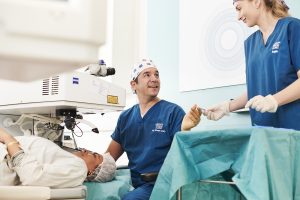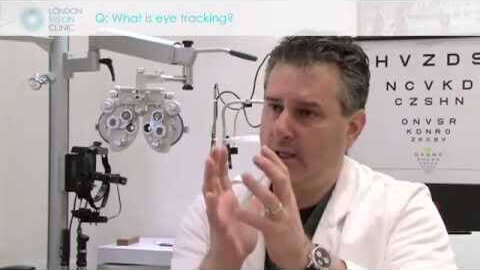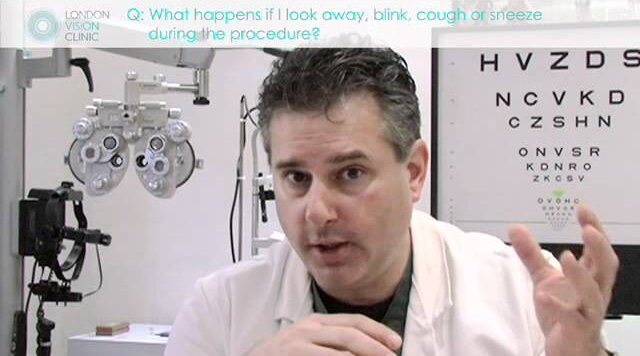What Happens if I Move My Eyes or Blink During Laser Eye Surgery?

Modern developments have helped to make Laser Eye Surgery safer, and more effective than ever before. Modern techniques have built on the practices of traditional refractive surgery to offer patients a surprisingly comfortable and speedy procedure. But it’s only natural to have some niggling worries when heading into the treatment room (and before!).
In the early days of refractive surgery, it was common for patients to look up to see a sharp, bladed instrument moving menacingly towards their eyeball…
“Don’t worry,” the surgeon smiles, “I’ve done this a thousand times – everything will be fine.”
Of course, the words would likely fall on deaf ears as the blade gets closer. All you would likely be able to think is “Dear God, please don’t move!”
Thankfully, the invention of the excimer and femtosecond laser has largely done away with the need for this slightly grizzly technique. But putting your eyes in the hands of a pre-programmed laser does beg another question: What happens if you blink or move your eyes during treatment?
Modern Laser Eye Surgery Technology
The introduction of laser technology helped to make refractive surgery safer and more straightforward than ever before. It was first introduced in the late 1980s and was utilised by a US-based company called IntraLase. In the years since, this technology has been continuously developed. Today, many high-quality clinics are home to incredibly precise lasers, Carl Zeiss Meditec VisuMax Femtosecond laser.]
There’s no denying that the human hand can be impressively meticulous in many settings. But why rely on them – and human eyesight – when we have more reliable and precise tools available to us? At modern Laser Eye Surgery clinics, world-class technology leads, providing a safer and more accurate treatment.
The Excimer laser – manufactured by the renowned optics company, Carl Zeiss Meditec – ensures auto-stabilised delivery and unparalleled accuracy. In fact, FDS trials of the Zeiss MEL 90 Excimer laser showed it to be the most accurate LASIK laser in the world.
Such significant developments in Laser Eye Surgery technology and techniques have all but removed the risk of human error in this ever-popular treatment. Not only does this make the procedure safer and faster than ever, but it also helps to limit – and in some cases, remove – the risk of complications.
But what about if you sneeze, cough, or blink during treatment?
Let’s get back to the worried patient who is afraid to move their eyes during their refractive surgery. Of course, this is understandable – at least if they were being treated with a blade. However, cutting-edge eye-tracking technology means you don’t need to worry about this when undergoing modern Laser Eye Surgery.

As our founder and expert Laser Eye Surgeon, Professor Dan Reinstein, explains in the video above, eye-tracking technology allows us to – well – track the position of your eyes!
It works by taking between 500 and 1000 photographs of the eye every single second. From this data, it determines whether your eye is in the correct position for treatment. If not, it instantaneously compensates for this, meaning any eye movements are factored into your treatment.
In other words, this incredible technology means that the results of your treatment will not be affected if you move your eyes during the procedure – even if you blink, sneeze, or fall off the bed! Or as Professor Reinstein puts it in the video below:
“…you could probably be playing tennis and still get the treatment at the same time put in the right place because eye trackers today are able to place the spots to within a 10th of a millimetre of where you want to place it.“

The Precision of Laser Eye Surgery
Another important factor in the precision of Laser Eye Surgery treatment is spot size.
This refers to the size of the laser at the point it makes contact with the eye. As you might expect, the smaller the spot size, the more precise the laser – a bit like how an artist uses a smaller brush for the most detailed parts of their work.
Smaller spot sizes mean that the laser is more focused on its target, allowing it to more effectively remove only the pre-determined area of corneal tissue. Different clinics often use different lasers – which in turn have different spot sizes. This means that the precision of your treatment can often depend on the clinic you choose.
At London Vision Clinic, we use the Zeiss MEL 90 and Zeiss MEL 100 Excimer lasers – the most precise in the world. These lasers have the smallest spot size available in the Laser Eye Surgery field. Moreover, the lasers’ fast movement and reaction times only add to this precision, significantly lowering the risk of complications.
So, if you’re worried about moving your eyes during your Laser Eye Surgery treatment, the advice is clear: Don’t be! To learn more about treatment at the London Vision Clinic, get in touch with one of our friendly clinic coordinators. Alternatively, Book a Consultation today.


